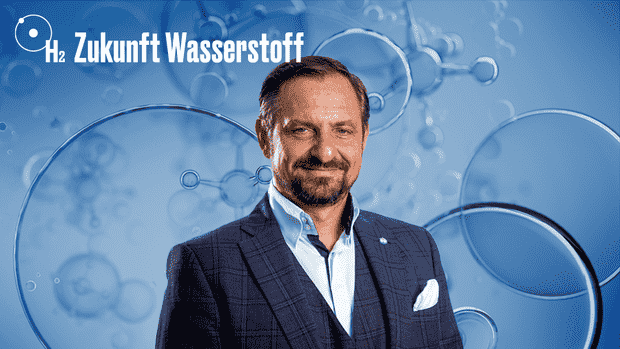Germany will only achieve its climate protection goals without the risk of de-industrialization if it strategically plans the need for green hydrogen – also in the course of the accelerated expansion of renewable energies. Renewables are experiencing record growth worldwide. In 2020 it was around 280 gigawatts (GW). The International Energy Agency (IEA) expects capacity to increase by a further 280 GW in 2022.
Green hydrogen, which has had a niche existence for far too long, will play an important role with the growing global share of renewable energies in order to master the massive increase in renewable electricity – also from the cost side. It will not work otherwise, even if ideological reasons are given in some places, which run counter to the climate protection goals.
Economics and Climate Minister Robert Habeck (Greens) approved the “H2Global” program in December 2021: 900 million euros for the global promotion of the hydrogen economy – with the aim of promoting the market ramp-up of green hydrogen. An important sign that sets the course for Germany to play a pioneering role on a global level.
Ambitious projects are pending not only in Germany but also in other countries. The artificial word “Hydrogenewables” refers to the direct production of green hydrogen using wind energy from offshore wind farms. Such projects are being promoted in the Scandinavian countries and the Netherlands, for example, where openness to technology is celebrated instead of backing a specific horse for climate protection from the outset.
Top jobs of the day
Find the best jobs now and
be notified by email.
Of course, the production of green hydrogen can also be efficiently realized with the help of solar energy – if the necessary solar radiation is available. As an example: Europe’s steel mills are among the most energy-intensive sectors. This branch of industry could produce emission-free with the help of green hydrogen. The amount of hydrogen required for this could be produced on 0.35 percent of the area of Spain with solar energy.
Production of green hydrogen relieves grids
However, green hydrogen can also be produced “on the side” – i.e. not as the main product – and thus be the solution to various problems, especially in Germany: among other things, for relieving the grid and for the use of regulated wind turbines.
The share of renewable energies in electricity consumption in Germany in 2021 was 42 percent – according to the preliminary evaluation by the office of the “Working Group on Renewable Energy Statistics” (AGEE-Stat) at the Federal Environment Agency (UBA) in December 2021.
One of the climate protection goals of the traffic light coalition: a faster expansion of renewable energies in Germany. However, this will result in greater volatility in power generation and higher utilization of the German power transmission grid.
Guest Commentary Series: Future Hydrogen
The network is already reaching its limits in many cases. This will intensify further with the expected additional demand for e-mobility. The resulting need to balance grid capacities drives up electricity prices. Germany already has the highest electricity costs in the EU. Green hydrogen can help here because it acts as an energy store.
So too much existing yield from renewable energies will not overload the power grid, but will be put into the production of green hydrogen. This can then either be transported via gas lines or used directly on site – for example to refuel hydrogen commercial vehicles (buses, trucks). There are already mature technologies for this that work in everyday life and are already used daily in many cities, such as Cologne.
By the way: Transporting green hydrogen via pipelines is at least seven times cheaper than transporting the same amount of energy via conventional electricity transport.
Green hydrogen therefore makes renewable energies cheaper, relieves grids and thus also helps with social acceptance of climate protection measures.
Germany needs the import
To date, Germany will not satisfy the hunger for green hydrogen alone: According to a study by the strategy consultancy Strategy&, demand in Germany will grow to 2.7 to 3.3 megatons (90 to 110 terawatt hours) in 2030. Of this, 0.4 megatons (14 terawatt hours) are to be produced locally. In other words, far too little for the energy-intensive chemical and steel industries.
Germany will not be able to avoid a significant import of green hydrogen. This is exactly where the “H2Global” program initiated by Habeck comes in.
The fact that the EU Commission, among others, knows this can be seen from the Nord Stream 2 compromise, which was reached in 2021 under the government of Angela Merkel (CDU): Ukraine will receive compensation payments. These are used for the production of green hydrogen. The new Foreign Minister Annalena Baerbock (Greens) impressively underpinned this offer on her first trip to Ukraine by setting up a dedicated office, which has been internationally referred to as “hydrogen diplomacy”.
The transport routes for green hydrogen via pipelines to the EU and thus to Germany are already in place. Green hydrogen is therefore not only important for a successful energy transition in the EU and thus in Germany, but also for countries that specialize in the production and export of this energy source and thus want to develop economically. A win-win situation for everyone.
Jorgo Chatzimarkakis is CEO of Hydrogen Europe, the association of the European hydrogen technology industry. From 2004 to 2014 he was a member of the European Parliament.
More: The EU cannot achieve its climate goals without green gas power plants
